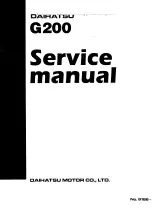
A tire this worn gives very little
traction on wet roads. You should
replace the tire if you can see three
or more tread wear indicators.
Every time you check inflation, you
should also examine the tires for
damage, foreign objects, and wear.
You should look for:
Bumps or bulges in the tread or
side of the tire. Replace the tire if
you find either of these conditions.
Cuts, splits, or cracks in the side
of the tire. Replace the tire if you
can see fabric or cord.
Excessive tread wear.
Your tires have wear indicators
molded into the tread. When the
tread wears down, you will see a 1/2
inch (12.7 mm) wide band across the
tread. This shows there is less than
1/16 inch (1.6 mm) of tread left on
the tire.
The service life of your tires is
dependent on many factors,
including, but not limited to, driving
habits, road conditions, vehicle
loading, inflation pressure,
maintenance history, speed, and
environmental conditions (even
when the tires are not in use).
The last four digits of the TIN (tire
identification number) are found on
the sidewall of the tire and indicate
the date of manufacture (See
on page
).
In addition to your regular
inspections and inflation pressure
maintenance, it is recommended that
you have annual inspections
performed once the tires reach five
years old. It is also recommended
that all tires, including the spare, be
removed from service after 10 years
from the date of manufacture,
regardless of their condition or state
of wear.
341
Tire Inspection
Tire Service Lif e
Tire
Labeling
Tires
Ma
int
e
na
nce
305
INDICATOR LOCATION MARKS
TREAD WEAR INDICATOR
Summary of Contents for 2010 Civic Hybrid
Page 6: ......
Page 60: ...U S models U S models Canadian models Canadian models Safety Labels 54 HOOD DOORJAMBS...
Page 117: ...Audio System Features 111 U S model with navigation system...
Page 356: ...350...
Page 362: ...356...
Page 371: ......
Page 372: ......
Page 373: ......
















































